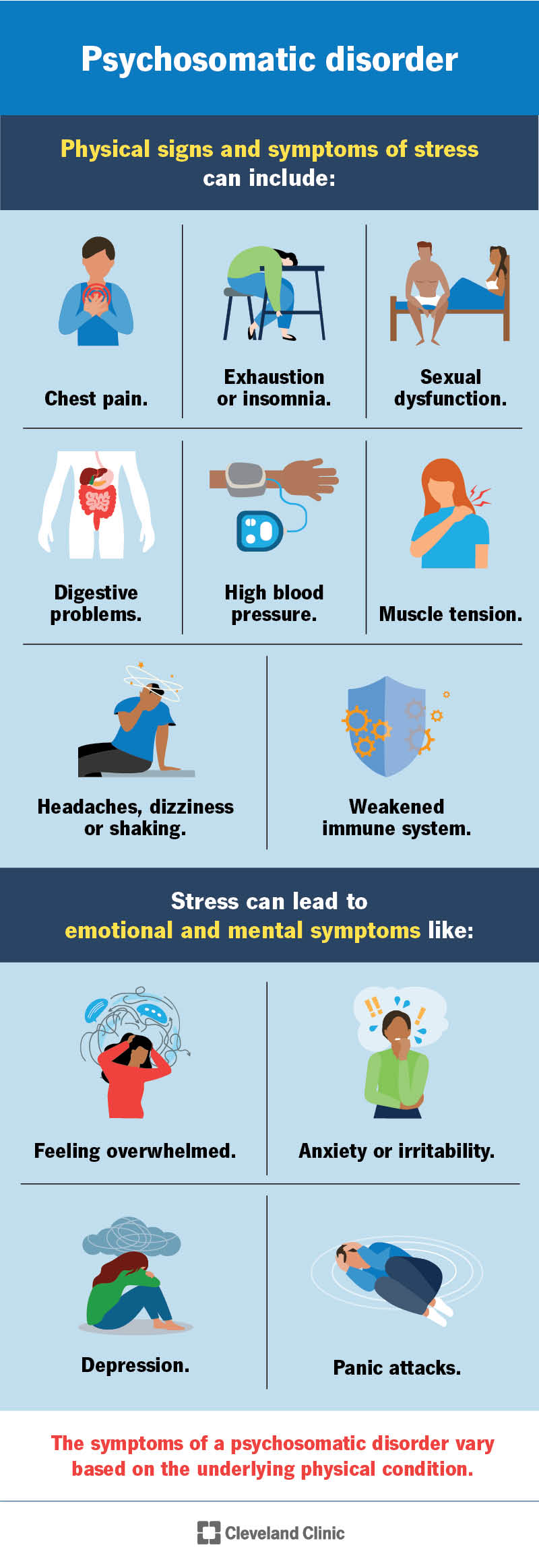A psychosomatic disorder is any physical condition that stress can help cause or make worse. Stress impacts our bodies in many ways and can affect several physical conditions, from heart disease to eczema. Stress management can go a long way to help manage psychosomatic disorders.
Advertisement
Cleveland Clinic is a non-profit academic medical center. Advertising on our site helps support our mission. We do not endorse non-Cleveland Clinic products or services. Policy
A psychosomatic disorder happens when mental stress and distress cause or make a physical condition — and its symptoms — worse.
Advertisement
Cleveland Clinic is a non-profit academic medical center. Advertising on our site helps support our mission. We do not endorse non-Cleveland Clinic products or services. Policy
“Psycho” means “relating to the mind.” “Somatic” means “relating to the body.”
In modern medicine, researchers debate the number of physical conditions — if any — that are truly the result of only stress and distress. This is because the majority of conditions have several factors that cause them — our bodies are very complex.
In the past, healthcare providers thought that stress caused conditions like tuberculosis and stomach ulcers. But advances in scientific research have shown that this isn’t true. (The bacterium Mycobacterium tuberculosis causes tuberculosis, and H. pylori infection causes stomach ulcers.)
Providers do recognize that many physical diseases involve psychosomatic factors, and that stress often makes them worse. Some of these conditions include:
Psychosomatic disorder and somatic symptom disorder both involve a combination of psychological issues and physical symptoms or conditions. But their cause-and-effect relationships are different.
Advertisement
Somatic symptom disorder happens when you have an extreme focus on physical symptoms, like pain, that causes major distress or problems with daily functioning. A psychosomatic disorder happens when stress makes physical conditions worse.
The American Psychiatric Association (APA)’s Diagnostic and Statistical Manual of Mental Disorders (DSM-5) recognizes somatic symptom disorder as a condition. It doesn’t recognize psychosomatic disorder as a condition.

The symptoms of a psychosomatic disorder vary based on the underlying physical condition.
For example, if you have diabetes, stress may raise your blood sugar levels or make them more difficult to manage. Stress and anxiety can cause flare-ups if you have digestive issues, leading to diarrhea, bloating, constipation or abdominal discomfort.
Physical signs and symptoms of stress specifically include:
Stress can lead to emotional and mental symptoms like:
Some people are more emotionally and physiologically sensitive to stress. They may be more likely to have psychosomatic disorders. When you experience stress, it causes the following changes in your body:
Most people can physically and mentally tolerate brief episodes of stress. But chronic or severe stress causes wear and tear on your body and mind if you’re naturally more reactive to stress. These bodily changes happen frequently and/or last longer than they should and damage body systems.
Advertisement
Researchers think many factors make a person more vulnerable to psychosomatic disorders and the effects of stress, including:
There are no specific criteria that healthcare providers use to diagnose a psychosomatic disorder. If you have a physical condition that stress can affect, like heart disease or gastrointestinal issues, your provider may ask you about your stress level to see if it could be affecting your physical health.
Stress is subjective. Only you can determine whether it’s present and how severe it feels. Your provider may use questionnaires to understand your stress and how it affects your life. They may recommend strategies for managing stress to try to lessen its effect on your symptoms.
Each physical condition that stress may contribute to or worsen has its own treatment. But your healthcare provider may recommend therapies to manage your stress specifically. These include:
They may give you a referral to a specialist in mental health (like a psychiatrist or psychologist) and recommend regular checkups with your primary care provider.
Advertisement
Many people learn to manage and lessen somatic pain symptoms over time. However, even with treatment, psychosomatic symptoms may come and go throughout life.
Some people are genetically more sensitive to stress. There’s nothing you can do to prevent psychosomatic effects in that regard.
But there are strategies to reduce and manage stress, which may help you prevent or lessen physical symptoms of a condition. Examples include:
Stress can affect your body in many ways. So, it’s important to see your healthcare provider if you’re experiencing chronic or severe stress, especially if you have a chronic physical condition, like heart disease or diabetes.
If you’re experiencing a lot of stress and have a physical condition, it may be helpful to ask your provider the following questions:
Advertisement
Illness anxiety disorder (hypochondria) happens when you have an unrealistic fear that you have a serious medical condition or that you’re at high risk of becoming ill. You may misinterpret typical body functions as signs of illness.
A psychosomatic disorder happens when stress — which may or may not be related to physical ailments — makes a physical condition worse.
If you’re experiencing chronic or severe stress, it’s always a good idea to see your healthcare provider. Stress can affect your physical — and mental — health in several ways. While it’s unlikely that stress is the sole cause of a physical condition, there’s no doubt that it can contribute to or worsen many conditions. Talk to your provider about ways to manage your stress and improve your physical health. They’re available to help.
Your mental well-being is just as important as your physical well-being. Cleveland Clinic’s mental health experts can help you live life to the fullest.

Last reviewed on 08/02/2024.
Learn more about the Health Library and our editorial process.